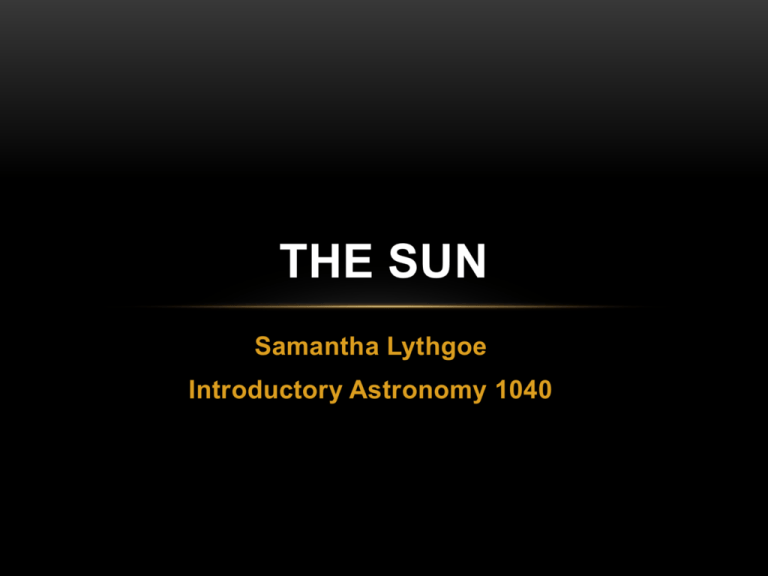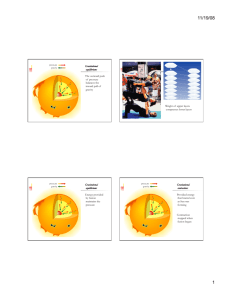
THE SUN
Samantha Lythgoe
Introductory Astronomy 1040
• The sun is the
nearest most
easily studied star
in our sky.
(Bennett 285)
• It is the source of virtually all light, heat and energy
reaching Earth, and the life on Earth’s surface could
not survive without it. (Bennett 285)
HOW DOES THE SUN SHINE?
• Gravitational Equilibrium keeps the core hot and dense enough
to release energy through the nuclear fusion of Hydrogen to
Helium.
• What is Gravitational Equilibrium?
• It is a state of balance in which the force of gravity pulling
inward is precisely counteracted by pressure pushing
outward.
• What is Nuclear Fusion?
• The process in which two or more smaller nuclei slam
together and make one larger nucleus. (bennett 302, G-6,
G-9)
NUCLEAR FUSION IN THE SUN
• “The core’s extreme temperature
and density are just right for
fusion of Hydrogen into Helium,
which occurs via the protonproton chain. Because the fusion
rate is so sensitive to
temperature, gravitational
equilibrium acts as a thermostat
that keeps the rate of fusion
steady” (Bennett 302)
THE STRUCTURE OF THE SUN
FROM THE OUTSIDE IN
• Corona- The outer most
layer of the suns
atmosphere. The corona
extends several million
kilometers above the
visible surface of the sun
and reaches about 1
million kelvin in
temperature. (Bennett 302)
LAYERS OF THE SUN
•
Chromosphere- A blanket of glowing
gasses surrounding the sun
measuring about 16000 kilometers
thick and 10,000 Kelvin. (bennett
302,Layers of the sun)
•
Photosphere- Lowest layer of the
atmosphere also the visible surface
of the sun. approx. 6,000 Kelvin.
This layer releases light that can be
seen from earth and is Where
sunspots and regions of intense
magnetic fields can be found.
LAYERS OF THE SUN
•
Convection Zone- 200,000 Kilometers of rising hot gasses and falling
cool gasses, this process is called convection and is most easily
related to boiling. Convection carries photons outward toward the
surface of the sun. Convection on the sun creates energy in the form
of light and heat.
•
Radiation Zone- In this zone energy is carried out from the core of the
sun by light photons.
•
Core- The innermost layer of the sun. The core’s temperature reaches
approx. 15 million kelvin. In the core fusion reactions occur and
produce energy in the form of gamma rays and neutrinos.
OTHER FUN FACTS
•
In addition to creating a gravitational equilibrium the suns gravity holds
the other planets in our solar system in orbit.
•
The sun is average in size, age and temperature
•
The sun is about 4.6 billion years old and will continue to shine for
another 7 billion years.
•
The sun and our solar system orbit around the Milky Way galaxy once
every 250 million years.
•
The reaction taking place in Sun is nuclear fusion, same as a
Hydrogen bomb.
•
Each second 700 million tons of Hydrogen are converted to 695
million tons of Helium and 5 million tons of energy in the form of
gamma rays.
SUN FACTS
•
The light takes 8.3 minutes to travel from the Sun to Earth.
•
It takes up to 50 million years for the energy produced at the core of
the Sun to reach its surface.
•
Solar flares are violent explosions taking place in the Sun's atmosphere
occasionally. Solar flares can reach more than 100,000 miles away from the
sun.
•
Sunspots appear as dark spots on the surface of the Sun. Sunspots are the
intense magnetic regions of Sun with magnetic field strengths thousands of
times stronger than the Earth's magnetic field.
SUMMARY
•
The sun shines with energy
generated by fusion of hydrogen
into helium in the suns core.
•
Gravitational Equilibrium
determines the suns interior
structure and helps create a
natural thermostat that keeps
fusion in the sun steady.
•
The sun is important not only as a
light and heat source, but also
because it is the only star near
enough for us to study in great
detail.
WORKS CITED
•
Bennett, Jeffrey, Megan Donahue, Nicolas Schneider
and Mark
Voit. The Essential Cosmic Perspective.
5th ed. California:
Pearson/Addison-Wesley, 2009.
Print.
•
“Nuclear Energy-Fission and Fusion.” Energystory.com.Energy
Quest, 1994-2011,
Web. 4 Dec. 2011.
•
“Layers of the Sun.” Planetfacts.com. Planet Facts.
Dec. 2011.
2011.Web. 4







